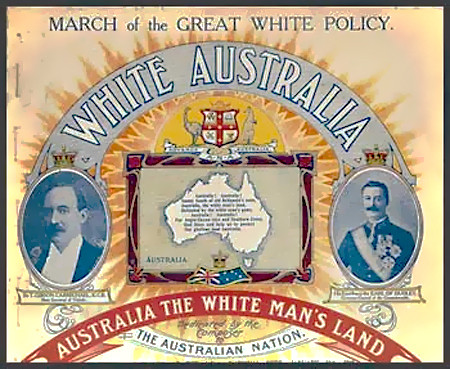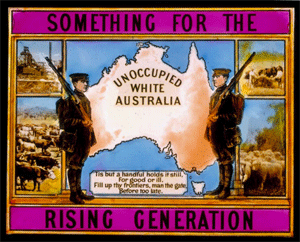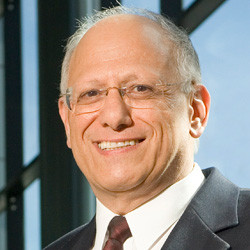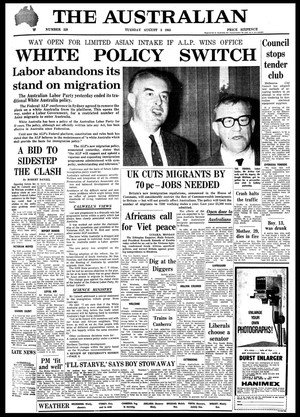The War on White Australia: A Case Study in the Culture of Critique, Part 1 of 5

READ MORE AT THE OCCIDENTAL OBSERVER
Editor’s note: Brenton Sanderson has written several articles on the Jewish war on White Australia. This is the first one, posted originally on August 13, 2012 as a 5-part series. Well worth reading or re-reading — and thinking about the world we have lost.
Results from the 2011 Australian Census reveal that, for the first time in that nation’s history, the majority of migrants are now arriving from Asia instead of Europe. Indians and Chinese have become the fastest growing sections of the Australian population. Between 2006 and 2011 the number of Australian permanent residents born in India increased by 100 per cent, those born in China increased by 54 per cent, while those born in the Philippines by 42 per cent. These startling figures do not even include those born in Australia to Indian or Chinese parents. The Census also revealed that other non-White immigrant groups are also expanding rapidly, including various African groups. All of this is dismal news for White Australians and, indeed, for White people everywhere. Unfortunately, these figures only mirror what is happening throughout the West, where White people are under demographic and cultural siege from race-replacing levels of Third World immigration and the official embrace of “multiculturalism.”
In just a few decades these malignant policies have transformed Western societies to the detriment of their European-derived populations and culture. It is a remarkable fact that this revolution in immigration and social policy throughout the West occurred at around the same time (1962-1973), and that in all countries these changes reflected the attitude of elites rather than the great mass of citizens. Changes in immigration policy and the imposition of multiculturalism were imposed on resentful European populations despite overwhelming popular opposition to non-European immigration. The driving force behind this totally undemocratic shift in policy was the Jewish intellectual movements and ethno-political activism that Kevin MacDonald documented in The Culture of Critique. For those aware of the pivotal role of Jews in driving the demographic and cultural transformation of the United States, the story of the Jewish role in radically reengineering Australian society will have a depressingly familiar ring to it.
Australia was the last habitable continent settled by Europeans. In 1901 the British colonies of Australia federated to form an independent nation. The first Act passed by the new federal parliament was the Immigration Restriction Act which, through imposing a dictation test in any European language (usually English), effectively barred non-White immigration to Australia. Until the cultural revolution of the 1960s, Australia remained an unashamedly White Christian nation with a strong Anglo-Celtic ethnic base. Indeed the long-running (now defunct) news magazine The Bulletin maintained the slogan “Australia for the White Man” on its masthead until 1961. By 1947 the non-European population, other than Aborigines, was measured at 0.25 per cent of the total. As a result of the Immigration Restriction Act, Australia had become, by this time, one of the Whitest countries in the world. Ian Cook makes the point that “The ‘White Australia’ policy was a fairly self-conscious and explicit attempt to protect a particular genetic inheritance from being diluted by other genetic lines.”[i] The policy was extraordinarily successful in this endeavor, and the historian Eric Richards observes that, in retrospect, it is extraordinary that so remote a settlement could maintain such a homogeneous population composition.[ii]
Australia and New Zealand were also the two most “British” societies outside the United Kingdom, and Australia was, proportionately, the most Irish society outside Ireland. The imperial loyalties of the Australian colonists were often explained by reference to the “crimson thread of kinship” that existed between Britain and Australia. Australian identity was founded upon three distinct yet interrelated components: racial Whiteness, “Britishness,” and “Australianness.”[iii] The attempted Japanese invasion of northern Australia in WWII proved that the longstanding fear of an Asian invasion (the “Yellow Peril”) was far from the neurotic, xenophobic anxiety disparaged by today’s politically correct historians. In the 1960s there was no popular movement for ending the White Australia policy, a policy that had retained the bipartisan support of Australia’s political class since its inception in 1901. Indeed, Richards notes that “Australia’s adherence to ‘Whiteness’ was its defining characteristic,” and that “None of the other great immigrant countries was able to sustain such a degree of homogeneity.”[iv] Hawkins makes the point that
the primary and identical motivation of Canadian and Australian politicians in trying to exclude first the Chinese, then other Asian migrants and finally all potential non-white immigrants, was the desire to build and preserve societies and political systems in their hard-won, distant lands very like those of the United Kingdom. They also wished to establish without challenge the primary role there of her founding peoples of European origin. … Undisputed ownership of these territories of continental size was felt to be confirmed forever, not only by the fact of possession, but by the hardships and dangers endured by the early explorers and settlers; the years of back-breaking work to build the foundations of urban and rural life. … The idea that other peoples, who had taken no part in these pioneering efforts, might simply arrive in large numbers to exploit important local resources, or to take advantage of these earlier settlement efforts, was anathema.[v]
Tied in with these natural and legitimate expressions of racial and ethnic solidarity, were concerns hordes of non-White immigrants would drive down the wages and living standards of White Australians. This was a key part of the original rationale for the White Australia policy as articulated by Alfred Deakin, Australia’s first Attorney-General, who argued that
a white Australia does not by any means just mean the preservation of the complexion of the people of this country. It means the multiplying of homes, so that we may be able to defend every part of our continent; it means the maintenance of conditions of life fit for white men and white women; it means equal laws and opportunities for all; it means protection against underpaid labour of other lands, it means the payment of fair wages. A white Australia means a civilisation whose foundations are built on healthy lives, lived in honest toil, under circumstances which imply no degradation; a white Australia means protection.”[vi]
An analogous view had been expressed as early as 1841 by James Stephen, the powerful head of the British colonial office in London, who declared that Australia should be a land “where the English race shall be spread from sea to sea unmixed with any lower caste.” He maintained that the introduction of Indian “coolies” into New South Wales would “debase by their intermixture the noble European race… bring with them the idolatry and debasing habits of their country… beat down the wages of poor laboring Europeans… [and] cut off the resource for many of our own distressed people.”[vii] Charles Pearson, a British scholar who migrated to the colonies in the late nineteenth century, published a book entitled National Life and Character in 1893. In it, he described Australia as “an unexampled instance of a great continent that has been left for the first civilized people that found it to take and occupy. He warned, nevertheless, that it was still questionable whether the white races would be able to hold on to it in the face of the Asiatic threat:
We know that coloured and white labour cannot exist side by side; we are well aware that China can swamp us with a single year’s surplus of population; and we know that if national existence is sacrificed to the working of a few mines and sugar plantations, it is not the Englishman and Australian alone, but the whole civilized world, that will be the losers.[viii]
Such concerns echoed through the decades of the White Australia policy, where the country explicitly defined its nationhood in terms of Whiteness and a policy of economic protectionism designed to benefit the entire group by preventing, say, Australian capitalists from importing cheap labor that would undercut the standard of living of other White Australians. The policy reflected the desire of Australians to build a strong and prosperous society founded upon the principles of racial and cultural homogeneity and fairness within the racial group. Gwenda Tavan notes that the White Australia policy was a “morally imbued affirmation of the type of society Australians wanted to build: white and British-Australian as well as cohesive, conformist, liberal-democratic and egalitarian.”[ix] One commentator reflected this view when noting in 1939 that “The Australian prides himself on his high standard of living; he wishes to do nothing that will endanger it. Neither does he wish to bring into being a colour problem such as he sees in South Africa.”[x]
Early twentieth century Australian poster
Rather than being driven by any shift in public opinion, the impetus for the progressive dismantling of the White Australia policy, and the move from assimilation to multiculturalism between 1966 and 1975 came “from a small group of reformers that began appearing in some Australian universities in the 1960s” who, like their counterparts in the United States and Britain, soon comprised a hostile intellectual, academic and media elite who “developed a sense of being a member of a morally and intellectually superior ingroup battling against Australian parochial non-intellectuals as an outgroup.”[xi] In the changing ideological climate of the 1950s and 1960s, the moral foundations of Australia’s British history were subjected to radical criticism, and once foundational patriotic works like Keith Hancock’s Australia (with its maxim that “among the Australians pride of race counted for more than love of country”) were no longer compulsory reading for students. [xii]
Boasian anthropology and the fall of White Australia
The Boasian ideology of racial egalitarianism (discussed in Chapter 2 of The Culture of Critique as a Jewish intellectual movement) was a critical weapon in opening Australian immigration up to non-White groups. Jewish academic Jon Stratton notes that the dismantling of the White Australia policy and the ultimate adoption of multiculturalism was a direct result of “internal and external pressures related to a general turning away from biological racialism.”[xiii] The Australian Jewish academic Andrew Markus articulates the standard critique of “white racism” that became prominent in the 1960s when he asserts that it was based on the notion that
(i) as a result of some (undefined) “natural” process, national groups (or ‘races’ or ‘cultures’) have inborn (‘essential’) qualities which will never alter; and (ii) there are inherent characteristics in such groups which interpose barriers against harmonious co-existence, not least against interbreeding of populations. Such ideas give rise to closed forms of nationalism which restrict membership to those qualified by birth or descent, in contrast to open forms which grant citizenship to individuals on the basis of residence and adherence to the governing principles of the nation. They justified European colonial rule; the denial of basic human rights and citizenship; segregation in the workplace, housing and education; and policies of genocide culminating in the “factories of death” established in the period of Nazi domination of continental Europe. Rarely challenged in western societies prior to 1940, the idea of biological racial difference lost much of its legitimacy in the aftermath of the Holocaust.[xiv]
It is obvious from this statement just how closely acceptance of the myth of racial equality from the 1960s onwards was bound up with Jewish post-Holocaust ethno-political activism. Note also the outright lies and hypocrisy in the above paragraph. The “(undefined) ‘natural’ process” that Markus claims is the wholly irrational basis for “racism” is the very well-defined process of human evolution itself. The differential evolution of human groups in response to selection pressures imposed by diverse environments, resulted, after thousands of years, in differences in external morphology and psychological traits—including intelligence as measured by IQ tests. The average intelligence of a group will profoundly influence the society that will be created by that group. There is nothing undefined, irrational, or pseudo-scientific about this whatsoever.
In his description of “closed” forms of nationalism which restrict “membership to those qualified by birth or descent” Markus could be describing traditional Judaism, with its strict endogamy and built-in assumptions of Jewish racial, intellectual and moral superiority. As always, however, Judaism is outside the critical frame of reference of such reflexively anti-White Jewish intellectuals. Jewish ethno-nationalism (exemplified in Israel’s racially restrictive immigration laws) is tacitly held to be legitimate and uncontroversial (indeed a moral imperative), while White nationalism is inherently illegitimate and morally corrupt.
The rampant hypocrisy of this is particularly striking given that Australian Jews have “been at the forefront of support for the right of the state of Israel to exist as a Jewish state, to determine its own security agenda, and to do what is needed to ensure its own survival.”[xv] Indeed, the academic and Australian Jewish activist Danny Ben Moshe points out that Australian Jewry is fiercely Zionist and “outdoes all other Diasporas in their commitment to Israel.” A 1993 survey of Melbourne Jewry found that 63 per cent had visited Israel with over 40 per cent having done so two or more times. This is compared with 36 per cent of American Jews. Australia also has the highest rate of aliyah in the world.[xvi] While strongly in favor of non-White immigration and racial-mixing among the non-Jews in Australia, a publication like the Australian Jewish News can openly express the view that for Jews, “Intermarriage has always been and will always be an individual, spiritual and communal tragedy. No amount of petty rationalising will ever change that.”[xvii]
Noting the incredible hypocrisy involved in simultaneously condemning white racialism while defending the Jewish ethno-nationalist state of Israel (and traditional Jewish prohibitions against intermarriage), Kevin MacDonald observes in The Culture of Critique that:
Ironically, many intellectuals who absolutely reject evolutionary thinking and any imputation that genetic self-interest might be important in human affairs also favor policies that are rather self-interestedly ethnocentric, and they often condemn the self-interested ethnocentric behavior of other groups, particularly any indication that the European-derived majority… is developing a cohesive group strategy and high levels of ethnocentrism in reaction to the groups strategies of others. … A Jew maintaining this argument should, to retain intellectual consistency, agree that the traditional Jewish concern with endogamy and consanguinity has been irrational. Moreover, such a person would also believe that Jews ought not attempt to retain political power in Israel because there is no rational reason to suppose that any particular group should have power anywhere. Nor should Jews attempt to influence the political process … in such a manner as to disadvantage another group or benefit their own. And to be logically consistent, one should also apply this argument to all those who promote immigration of their own ethnic groups, the mirror image of group-based opposition to such immigration.[xviii]
Since the academic world is international and hierarchical, it was inevitable that intellectual movements originating in elite American universities spread throughout the West (see “Liberal Bias in Academia: The role of Jewish academics in the creation and maintenance of academic liberalism“) As a consequence of the growing influence of the Jewish intellectual movements described in The Culture of Critique, and direct Jewish activism in Australia, “Such views [i.e. the assumption racial equality] became standard within schools and universities and provided the intellectual basis for campaigns against racial discrimination in the late 1950s and 1960s.”[xix] Tavan notes that: “As a result of these shifts, universities in particular became ‘hotbeds of resistance’ to White Australia during the late 1950s and early 1960s. … The emergence of a body of Marxist-inspired social theory in Europe and the United States at that time also reinvigorated radical left-wing political theory in Australia.” For Tavan, the new critical theory of the Frankfurt School “played a crucial role in exposing the racist underpinnings of many of Australia’s key institutions and values.”[xx] The Frankfurt School abandoned the White working class because they were insufficiently radical and had succumbed to fascism in Germany and Italy. This caused them to reject the orthodox Marxist emphasis on class struggle, replacing it by advocating non-White immigration and multiculturalism, as well as recruiting Whites who had complaints against the traditional culture, particularly feminists and sexual minorities, into a new coalition of the left.
With the adoption in 1963 of the UN Declaration on the Elimination of All Forms of Racial Discrimination, member governments were urged to eliminate racial discrimination from their society altogether. Internal intellectual currents were thus augmented by mounting external political opposition to the White Australia policy, especially during the years of European decolonization in Africa and Asia. Eric Richards notes how
Prime Minister Menzies [1949-1966] was increasingly vexed by the intrusion of racial and immigration issues at meetings of Commonwealth Heads of Government. Menzies (and even more vehemently, one of his successors, John Gorton) loathed the way in which he was lectured on the “principle of racial equality” by newcomer members of the Commonwealth. Menzies and Gorton [1968-1971] believed that Australia’s immigration policy was perfectly defensible and, in any case, none of their business. But the die was already cast. Australia in the 1960s felt pressure from within and from beyond, and its immigration policy was a growing embarrassment.[xxi]
Senior Australian public servants serving on a committee formed to respond to the changed situation agreed in 1964 that “there was an urgent need to remove, as far as practicable, instances of racial discrimination in Australia in order to ensure Australia’s international reputation and influence are not to be seriously endangered.”[xxii] In response to these internal and external pressures, the administrative apparatus of the White Australia policy was gradually dismantled from the mid-1960s, until, in 1974, the then Labor Prime Minister, Gough Whitlam (1972-1975), declared in a speech that: “On Immigration, we have removed the last remaining pieces of legislation which could be described as discriminatory on racial grounds.”[xxiii]
According to the Australian academic and multicultural activist Bronwyn Hinz, this policy change merely formalized shifts in policy approach that had begun in the 1960s in response to reforms to the United States migration policy.[xxiv] Richards observes that this “hesitating shift towards a non-discriminatory Australia” triggered “a social and demographic revolution” in Australia[xxv] In both America and Australia, Jewish intellectual movements and political activism were pivotal in driving this revolution. The national editor of the Australian Jewish News, Dan Goldberg proudly acknowledges this, noting that: “In addition to their activism on Aboriginal issues, Jews were instrumental in leading the crusade against the White Australia policy, a series of laws from 1901 to 1973 that restricted non-White immigration to Australia.” The exact nature of this crusade will be explored in subsequent parts of this essay.
REFERENCES
Ben-Moshe, D. (2006) ‘The End of Unconditional Love: The Future of Zionism in Australian Jewish LIfe,’ In: New Under the Sun – Jewish Australians on Religion, Politics & Culture, Ed. Michael Fagenblat, Melanie Landau & Nathan Wolski, Black Inc., Melbourne. pp. 108-125.
Cook, I. (1999) Liberalism in Australia, Oxford University Press, Melbourne.
Curthoys, A. (2008) ‘Indigenous Subjects,’ In: Australia’s Empire, Ed. Deryck Schreuder & Stuart Ward, Oxford University Press, New York. pp. 78-102.
Fagenblat, M., Landau, M. & Wolski, N. (2006) ‘Will the Centre Hold?,’ In: New Under the Sun – Jewish Australians on Religion, Politics & Culture, Ed. Michael Fagenblat, Melanie Landau & Nathan Wolski, Black Inc., Melbourne. pp. 3-16.
Hancock, W.K. (1930) Australia, London.
Hinz, B. (2010) ‘Ethnic associations, networks and the construction of Australian multiculturalism,’ Paper presented at the Canadian Political Science Association Annual Conference, Corcordia University, Montreal, 1‐3 June.
Jupp, J. (2002) From White Australia to Woomera – The Story of Australian Immigration, Cambridge University Press, Melbourne.
MacDonald, K. B. (1998/2001) The Culture of Critique: An Evolutionary Analysis of Jewish Involvement in Twentieth‑Century Intellectual and Political Movements, Westport, CT: Praeger. Revised Paperback edition, 2001, Bloomington, IN: 1stbooks Library.
Markus, A. (2001) Race: John Howard and the remaking of Australia, Allen & Unwin, NSW.
Pearson, C. (1893) National Life and Character: A Forecast, MacMillan & Co., London.
Richards, E. (2008) ‘Migrations: The Career of British White Australia,’ In: Australia’s Empire, Ed. Deryck Schreuder & Stuart Ward, Oxford University Press, New York. pp. 163-185.
Stratton, J. (2000) Coming Out Jewish – Constructing Ambivalent Identities, Routledge, London.
Szego, J. (2006) ‘Marry Identities,’ In: New Under the Sun – Jewish Australians on Religion, Politics & Culture, Ed. Michael Fagenblat, Melanie Landau & Nathan Wolski, Black Inc., Melbourne. pp. 39-45.
Tavan, G. (2
[i] Cook p. 4
[ii] Jupp p. 9
[iii] Tavan p. 13
[iv] Richards p. 163
[v] Hawkins in MacDonald pp. 301-302
[vi] Cook p. 179
[vii] Richards pp. 167-168
[viii] Pearson p. 16
[ix] Tavan, p. 19
[x] Richards p. 173
[xi] MacDonald p. 302-303
[xii] Hancock p. 56
[xiii] Stratton p. 223
[xiv] Markus pp. 5-6
[xv] Fagenblat et al. p. 10-11
[xvi] Ben Moshe p. 108
[xvii] Szego p. 41
[xviii] MacDonald p. 311 & pp. 324-325
[xix] Markus p. 7
[xx] Tavan p. 116 & 168
[xxi] Richards p. 179
[xxii] Curthoys p. 99
[xxiii] Stratton p. 223
[xxiv] Hinz p. 3
[xxv] Richards p. 182












Excellent article Mr Brendon Sanderson.
The enemy within our gates has always been the Jewish Zionist one that has infiltrated our universities and then Governments to encourage trained people to disrupt and speak out about any suggestion of Australian culture to remain Australian.
The pathetic, hypocritical stance of Zionist Jews concerning multiculturalism in Australia whilst their genocidal actions and Immigratory policies in Palestine is assuredly a planned agenda to destroy any Whiteness in Australia.
For some strange reason the Jew hate of the White race is millennia old and maybe it is a hate against all races but the White race has excelled and therefore is the enemy to be destroyed.
Multiculturism has not worked and never will unless under a Communist totalitarian control and Communism is another arm of Zionism.